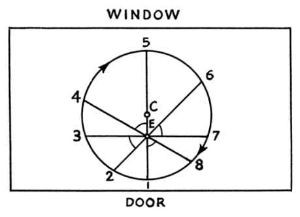The Sleepwalkers (151 page)
Authors: Arthur Koestler

This
idea
was
not
only
a
challenge
to
antique
tradition;
it
also
reversed
the
original
purpose
of
Copernicus.
It
will
be
remembered
that
Copernicus'
original
motive
for
embarking
on
a
reform
of
the
Ptolemaic
system
was
his
discontent
with
the
fact
that,
according
to
Ptolemy,
a
planet
did
not
move
at
uniform
speed
around
the
centre
of
its
orbit,
but
only
around
a
point
at
some
distance
from
the
centre.
This
point
was
called
the
punctum
equans
–
the
point
in
space,
from
which
the
planet
gave
the
illusion
of
"equal
motion".
Canon
Koppernigk
regarded
this
arrangement
as
an
evasion
of
the
command
of
uniform
motion,
abolished
Ptolemy's
equants,
and
added,
instead,
more
epicycles
to
his
system.
This
did
not
make
the
planet's
real
motion
either
circular,
or
uniform,
but
each
wheel
in
the
imaginary
clockwork
which
was
supposed
to
account
for
it,
did
turn
uniformly
–
if
only
in
the
astronomer's
mind.
When
Kepler
renounced
the
dogma
of
uniform
motion,
he
was
able
to
throw
out
the
epicycles
which
Copernicus
had
introduced
to
save
it.
Instead,
he
reverted
to
the
equant
as
an
important
calculating
device:

Let
the
circle
be
the
track
of
a
toy
train
chugging
round
a
room.
When
near
the
window
it
runs
a
little
faster,
near
the
door
a
little
slower.
Provided
that
these
periodic
changes
of
speed
follow
some
simple,
definite
rule,
then
it
is
possible
to
find
a
punctum
equans,
"E",
from
which
the
train
seems
to
move
at
uniform
speed.
The
closer
we
are
to
a
moving
train,
the
faster
it
seems
to
move;
hence
the
punctum
equans
will
be
somewhere
between
the
centre
C
of
the
track
and
the
door,
so
that
the
speed-surplus
of
the
train
when
passing
the
window
will
be
eliminated
by
distance,
its
speed-deficiency
at
the
door
compensated
by
closeness.
The
advantage
gained
by
the
introduction
of
this
imaginary
punctum
equans
is
that,
seen
from
E
,
the
train
seems
to
move
uniformly,
that
is,
it
will
cover
equal
angles
at
equal
times
–
which
makes
it
possible
to
compute
its
various
positions
1,
2,
3,
etc.,
at
any
given
moment.
By
these
three
preliminary
moves:
(a)
the
shifting
of
the
system's
centre
into
the
sun;
(b)
the
proof
that
the
orbital
planes
do
not
"oscillate"
in
space,
and
(c)
the
abolition
of
uniform
motion,
Kepler
had
cleared
away
a
considerable
amount
of
the
rubbish
that
had
obstructed
progress
since
Ptolemy,
and
made
the
Copernican
system
so
clumsy
and
unconvincing.
In
that
system
Mars
ran
on
five
circles;
after
the
clean-up,
a
single
eccentric
circle
must
be
sufficient
–
if
the
orbit
was
really
a
circle.
He
felt
confident
that
victory
was
just
around
the
corner,
and
before
the
final
attack
wrote
a
kind
of
obituary
notice
for
classical
cosmology:
"Oh,
for
a
supply
of
tears
that
I
may
weep
over
the
pathetic
diligence
of
Apianus
[author
of
a
very
popular
textbook]
who,
relying
on
Ptolemy,
wasted
his
valuable
time
and
ingenuity
on
the
construction
of
spirals,
loops,
helixes,
vortices
and
a
whole
labyrinth
of
convolutions,
in
order
to
represent
that
which
exists
only
in
the
mind,
and
which
Nature
entirely
refuses
to
accept
as
her
likeness.
And
yet
that
man
has
shown
us
that,
with
his
penetrating
intelligence,
he
would
have
been
capable
of
mastering
Nature."
6
3.
The First Assault
Kepler's
first
attack
on
the
problem
is
described
in
great
detail
in
the
sixteenth
chapter
of
the
New
Astronomy
.
The
task
before
him
was
to
define
the
orbit
of
Mars
by
determining
the
radius
of
the
circle,
the
direction
(relative
to
the
fixed
stars)
of
the
axis
connecting
the
two
positions
where
Mars
is
nearest
and
farthest
from
the
sun
(perihelion
and
aphelion),
and
the
positions
of
the
sun
(S),
orbital
centre
(C),
and
punctum
equals
(E),
which
all
lie
on
that
axis.
Ptolemy
had
assumed
that
the
distance
between
E
and
C
was
the
same
as
between
C
and
S,
but
Kepler
made
no
such
assumption,
which
complicated
his
task
even
more.
7
